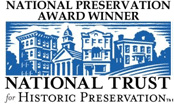Antique or Modern – Preservation Cafe
Posted on March 4th, 2017
Is that transom over your door a 1890s treasure or a 1980s addition? Can’t tell your cast iron from your mild steel? And what color did people paint their houses in the 1920s, anyway? The March 15, 2017 Preservation Café featured local architectural conservator and Capitol Hill resident, Justine P. Bello, speaking on the topic “Antique or Modern: Identifying Original Architectural Details in Your Home.”
Ms. Bello introduced several “lenses” through which the homeowner can look at his or her home to help interpret the built fabric. This process should always begin by looking at the greater context of a particular row of homes, or even an entire block: are there obvious patterns that help you understand how your house fits into the greater whole? Are there obvious “scars” that tell of features that might have been lost? Does a unique element stick out amongst its neighbors? This is the sort of framework in which we can start to evaluate the clues in plain sight about the chronology of our property.
Ms. Bello proceeded to present a variety of specific case studies with useful tips towards interpreting different aspects of Capitol Hill homes. Although there are exceptions to everything, the following examples are based on general trends.
- Does that transom window over your door have functional hardware like hinges and a latch? Has the sash been painted over at least a dozen times, leaving the molding edges looking soft and indistinct? Chances are it’s original. If the transom lacks functional hardware, and the lines of the sash appear crisp with few coats of paint, it’s more likely to be a replacement.
- Is your house wood? It would have always been painted—although maybe not the color it is today! Is your house brick? Most likely it would not have been originally painted; more likely, this was an addition in the second half of the 20th century.
- Exposed brick wall are a phenomenon of the late 20th century. The wall would have originally been covered by a multi-coat system of plaster.
Ms. Bello couched her discussion in the question: why does it matter? She strongly cautions against equating “old” with “good” and “new” with “bad.” Rather, she encourages each homeowner to get to know his or her home for a variety of reasons. Doing so can help you make informed decisions, understand regulatory requirements (where applicable), and in general, foster a deeper appreciation for what makes each property so special.
The Preservation Café series is a free forum with topics of interest to the greater Capitol Hill community.
The event was held at the Northeast Library, 330 7th St. NE, in the downstairs meeting room.


